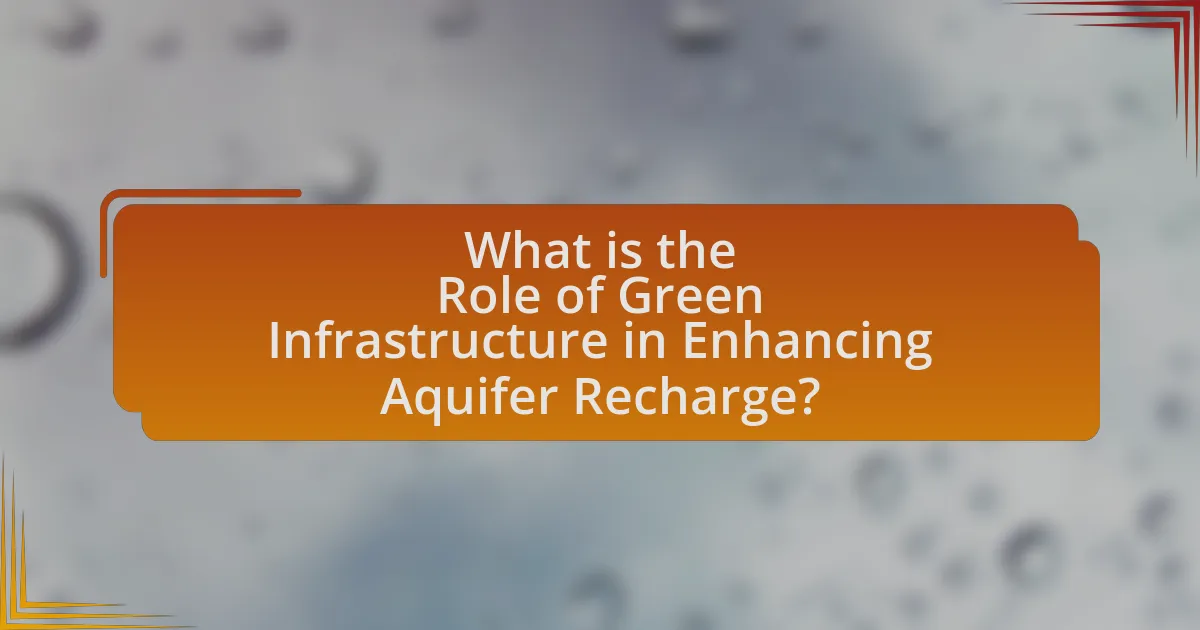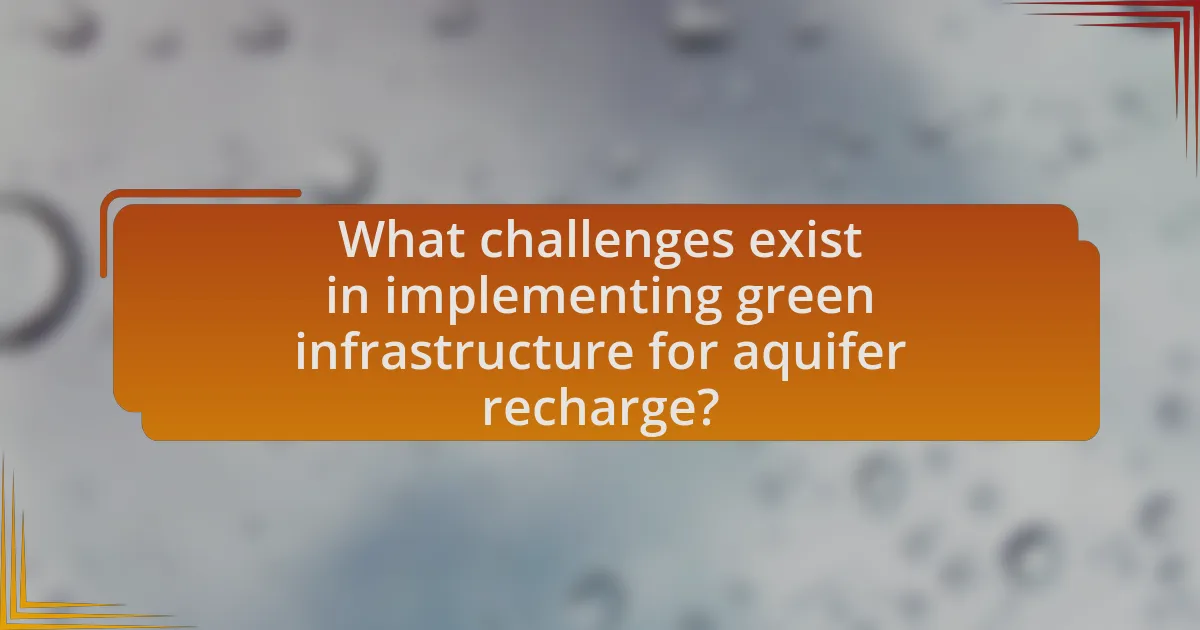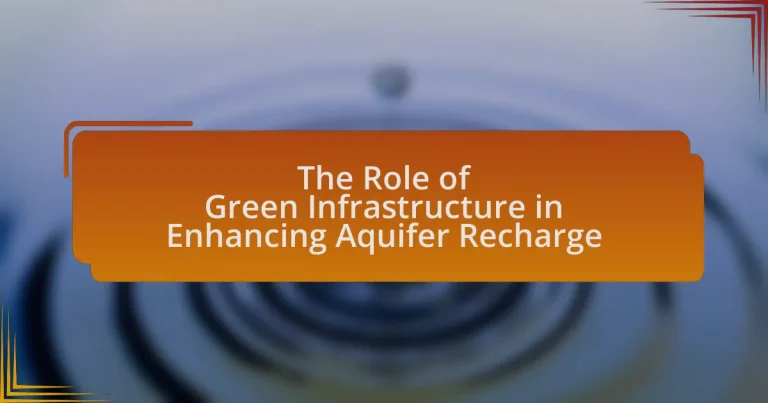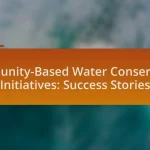Green infrastructure is essential for enhancing aquifer recharge by promoting the infiltration of rainwater and stormwater into the ground. Key components such as permeable pavements, green roofs, rain gardens, and bioswales facilitate this process, significantly reducing surface runoff and increasing groundwater levels. The article discusses how these practices interact with the hydrological cycle, their importance for sustainable water management, and the environmental benefits they provide. Additionally, it addresses challenges in implementing green infrastructure, funding opportunities, and future trends in aquifer recharge practices.
What is the Role of Green Infrastructure in Enhancing Aquifer Recharge?

Green infrastructure plays a crucial role in enhancing aquifer recharge by facilitating the infiltration of rainwater and stormwater into the ground. This approach utilizes permeable surfaces, green roofs, rain gardens, and bioswales to capture and manage precipitation, allowing water to percolate through soil layers and replenish underground aquifers. Studies indicate that implementing green infrastructure can significantly increase groundwater levels; for instance, a report by the U.S. Environmental Protection Agency highlights that green infrastructure practices can reduce surface runoff by 30-50%, thereby promoting aquifer recharge.
How does green infrastructure contribute to aquifer recharge?
Green infrastructure contributes to aquifer recharge by facilitating the infiltration of rainwater and stormwater into the ground. This process occurs through permeable surfaces, such as green roofs, permeable pavements, and bioretention areas, which allow water to seep through and reach the aquifer. Studies have shown that implementing green infrastructure can significantly increase the amount of water that infiltrates the soil, thereby enhancing groundwater levels. For instance, a study published in the journal “Water” found that green roofs can reduce runoff by up to 65%, allowing more water to percolate into the ground and recharge aquifers.
What are the key components of green infrastructure that aid aquifer recharge?
The key components of green infrastructure that aid aquifer recharge include permeable pavements, green roofs, rain gardens, and bioswales. Permeable pavements allow water to infiltrate through surfaces, reducing runoff and promoting groundwater replenishment. Green roofs capture rainwater, which can then evaporate or be absorbed, minimizing stormwater runoff and enhancing infiltration. Rain gardens are designed to collect and absorb rainwater, filtering pollutants and facilitating groundwater recharge. Bioswales, which are landscape elements designed to concentrate or remove debris and pollution from surface runoff, also enhance aquifer recharge by directing water to permeable areas. These components collectively improve water infiltration and reduce surface runoff, thereby supporting aquifer recharge.
How do these components interact with the hydrological cycle?
Green infrastructure components, such as permeable pavements, green roofs, and rain gardens, interact with the hydrological cycle by facilitating water infiltration, reducing surface runoff, and enhancing groundwater recharge. These components allow rainwater to percolate through soil layers, which increases the amount of water that replenishes aquifers. For instance, studies have shown that permeable pavements can reduce runoff by up to 80%, allowing more water to enter the ground rather than flowing into storm drains. This interaction not only supports aquifer recharge but also mitigates flooding and improves water quality by filtering pollutants.
Why is aquifer recharge important for sustainable water management?
Aquifer recharge is crucial for sustainable water management because it replenishes groundwater supplies, ensuring a reliable source of water for various uses. This process mitigates the impacts of droughts and reduces the dependency on surface water, which can be subject to seasonal fluctuations. Studies indicate that managed aquifer recharge can enhance water quality by filtering contaminants and improving the overall health of the aquifer system. For instance, the U.S. Geological Survey reports that aquifer recharge can help maintain water levels in aquifers, which is essential for ecosystems and human consumption.
What are the environmental benefits of enhanced aquifer recharge?
Enhanced aquifer recharge provides significant environmental benefits, including improved water quality, increased groundwater levels, and enhanced ecosystem health. By allowing water to percolate through soil and rock layers, enhanced recharge helps filter pollutants, thus improving the quality of groundwater. Additionally, it replenishes aquifers, which can mitigate the effects of drought and support sustainable water supply for ecosystems and human use. Studies have shown that areas with enhanced aquifer recharge can experience a rise in local biodiversity, as healthy groundwater systems support wetlands and other habitats.
How does aquifer recharge impact local ecosystems?
Aquifer recharge positively impacts local ecosystems by maintaining groundwater levels, which supports vegetation and wildlife habitats. When aquifers are recharged, the increased water availability enhances soil moisture, promoting plant growth and sustaining diverse ecosystems. For instance, studies have shown that areas with effective aquifer recharge practices experience improved biodiversity, as native plant species thrive and provide habitat for various animal species. Additionally, healthy aquifers contribute to the stability of surface water bodies, such as rivers and lakes, which are crucial for aquatic life.
What types of green infrastructure are most effective for aquifer recharge?

The most effective types of green infrastructure for aquifer recharge include permeable pavements, green roofs, rain gardens, and constructed wetlands. Permeable pavements allow water to infiltrate through surfaces, reducing runoff and promoting groundwater replenishment. Green roofs capture rainwater, which can then be absorbed by the underlying soil, facilitating aquifer recharge. Rain gardens are designed to collect and absorb stormwater, enhancing infiltration rates. Constructed wetlands mimic natural processes to filter and store water, allowing it to percolate into the ground. Studies have shown that these green infrastructure practices significantly improve aquifer recharge rates by increasing water infiltration and reducing surface runoff.
How do permeable pavements facilitate aquifer recharge?
Permeable pavements facilitate aquifer recharge by allowing water to infiltrate through their surface and into the underlying soil and groundwater systems. This infiltration process reduces surface runoff, enabling rainwater and stormwater to percolate downwards, which replenishes aquifers. Studies have shown that permeable pavements can significantly increase the volume of water that reaches the groundwater table, with some systems allowing up to 80% of precipitation to infiltrate. This capability is crucial for maintaining groundwater levels, especially in urban areas where traditional impervious surfaces dominate and contribute to increased runoff and reduced aquifer recharge.
What materials are used in permeable pavements?
Permeable pavements are primarily constructed using materials such as porous asphalt, pervious concrete, and interlocking concrete pavers. These materials are designed to allow water to infiltrate through their surfaces, facilitating groundwater recharge and reducing surface runoff. The use of these specific materials is supported by their ability to create void spaces that enable water to pass through, thus enhancing aquifer recharge and promoting sustainable stormwater management practices.
How does the design of permeable pavements influence their effectiveness?
The design of permeable pavements significantly influences their effectiveness by determining the rate and volume of water infiltration. Effective designs incorporate materials and structures that allow water to pass through, such as porous concrete or interlocking pavers, which facilitate drainage and reduce surface runoff. Research indicates that permeable pavements can reduce stormwater runoff by up to 80%, enhancing aquifer recharge by allowing more water to infiltrate into the ground. Additionally, the design must consider factors like subgrade conditions and maintenance practices to ensure long-term functionality and prevent clogging, which can diminish their effectiveness over time.
What role do green roofs play in enhancing aquifer recharge?
Green roofs significantly enhance aquifer recharge by capturing and retaining rainwater, which reduces surface runoff and promotes infiltration into the soil. This process allows water to percolate through the layers of the green roof, facilitating groundwater replenishment. Studies indicate that green roofs can retain up to 75% of rainfall, depending on their design and vegetation, thereby contributing to increased aquifer levels. Additionally, the vegetation on green roofs helps to slow down the flow of water, allowing more time for it to seep into the ground, further supporting aquifer recharge.
How do green roofs manage stormwater runoff?
Green roofs manage stormwater runoff by absorbing and retaining rainwater through their vegetation and substrate layers. The plants and soil on green roofs capture precipitation, which reduces the volume of water that reaches the drainage system. Studies indicate that green roofs can retain 60-100% of rainfall during light to moderate storms, significantly mitigating runoff. Additionally, the retained water is gradually released through evaporation and plant uptake, further decreasing peak flow rates and promoting aquifer recharge.
What are the maintenance requirements for green roofs to maximize aquifer recharge?
Green roofs require regular maintenance, including vegetation management, irrigation, and substrate monitoring, to maximize aquifer recharge. Proper vegetation management involves ensuring plant health and diversity, which enhances water retention and infiltration. Regular irrigation, especially during dry periods, supports plant growth and prevents substrate desiccation, allowing for optimal water absorption. Additionally, monitoring the substrate for compaction and nutrient levels is crucial, as healthy substrate promotes effective water infiltration and reduces runoff. Studies indicate that well-maintained green roofs can significantly improve stormwater management and aquifer recharge rates, demonstrating the importance of these maintenance practices.
What challenges exist in implementing green infrastructure for aquifer recharge?

Implementing green infrastructure for aquifer recharge faces several challenges, including high initial costs, land availability, and regulatory hurdles. High initial costs can deter investment, as projects often require significant funding for design, construction, and maintenance. Limited land availability in urban areas complicates the integration of green infrastructure, as space is needed for features like rain gardens and permeable pavements. Additionally, regulatory hurdles can arise from existing water management policies that may not support innovative approaches to aquifer recharge, making it difficult to gain necessary approvals. These challenges collectively hinder the widespread adoption of green infrastructure solutions aimed at enhancing aquifer recharge.
What are the common barriers to adopting green infrastructure?
Common barriers to adopting green infrastructure include high initial costs, lack of technical knowledge, regulatory challenges, and insufficient public awareness. High initial costs deter many municipalities and developers from investing in green infrastructure projects, as they often require significant upfront capital compared to traditional infrastructure. Lack of technical knowledge among stakeholders can lead to uncertainty about the design, implementation, and maintenance of green systems, hindering adoption. Regulatory challenges arise when existing policies do not support or incentivize green infrastructure, making it difficult for projects to gain approval. Lastly, insufficient public awareness about the benefits of green infrastructure can result in limited community support, which is crucial for successful implementation.
How can policy changes support the implementation of green infrastructure?
Policy changes can support the implementation of green infrastructure by establishing regulatory frameworks that incentivize sustainable practices. For instance, policies that provide financial incentives, such as tax credits or grants, encourage municipalities and developers to invest in green infrastructure projects like permeable pavements and rain gardens. Research from the American Society of Civil Engineers indicates that such incentives can lead to a 30% increase in green infrastructure adoption in urban areas. Additionally, policies that mandate the integration of green infrastructure in new developments ensure that these practices become standard, thereby enhancing aquifer recharge and improving water quality.
What funding opportunities are available for green infrastructure projects?
Funding opportunities for green infrastructure projects include federal grants, state programs, and private investments. The U.S. Environmental Protection Agency (EPA) offers funding through programs like the Clean Water State Revolving Fund, which supports projects that improve water quality and promote green infrastructure. Additionally, the National Fish and Wildlife Foundation provides grants specifically for projects that enhance natural resources, including green infrastructure initiatives. Local governments often have their own funding mechanisms, such as municipal bonds or dedicated tax revenues, to support these projects. These funding sources are critical for advancing green infrastructure, which plays a vital role in enhancing aquifer recharge and overall environmental sustainability.
How can communities effectively integrate green infrastructure for aquifer recharge?
Communities can effectively integrate green infrastructure for aquifer recharge by implementing practices such as rain gardens, permeable pavements, and green roofs. These practices enhance water infiltration and reduce surface runoff, allowing more water to percolate into the ground and replenish aquifers. For instance, a study by the U.S. Environmental Protection Agency found that rain gardens can capture and infiltrate up to 90% of stormwater runoff, significantly contributing to aquifer recharge. Additionally, using permeable materials for roads and parking lots can increase groundwater recharge by allowing rainwater to seep through, rather than flowing into storm drains.
What best practices should communities follow when designing green infrastructure?
Communities should prioritize the integration of native vegetation, permeable surfaces, and water management systems when designing green infrastructure. Utilizing native plants enhances biodiversity and reduces maintenance costs, while permeable surfaces facilitate groundwater recharge by allowing rainwater to infiltrate the soil. Additionally, implementing rain gardens and bioswales effectively manages stormwater runoff, promoting aquifer recharge. Research indicates that green infrastructure can reduce urban flooding by up to 30%, demonstrating its effectiveness in managing water resources sustainably.
How can public awareness and education enhance community involvement in aquifer recharge efforts?
Public awareness and education can significantly enhance community involvement in aquifer recharge efforts by informing residents about the importance of aquifers and sustainable water management practices. When communities understand the critical role aquifers play in providing clean water and the impact of their actions on these resources, they are more likely to participate in recharge initiatives. For instance, educational programs that highlight the benefits of green infrastructure, such as rain gardens and permeable pavements, can motivate residents to adopt practices that support aquifer recharge. Research indicates that communities engaged in educational outreach are more likely to implement water conservation measures, as evidenced by a study published in the Journal of Environmental Management, which found that informed communities increased their participation in local water management programs by 40%.
What are the future trends in green infrastructure and aquifer recharge?
Future trends in green infrastructure and aquifer recharge include the increased integration of nature-based solutions, such as green roofs, permeable pavements, and rain gardens, which enhance water infiltration and reduce runoff. These practices are supported by growing urbanization and climate change concerns, prompting cities to adopt sustainable water management strategies. Research indicates that implementing green infrastructure can significantly improve aquifer recharge rates; for instance, a study published in the journal “Water” found that green roofs can increase stormwater retention by up to 80%, thereby facilitating groundwater replenishment. Additionally, advancements in technology, such as smart water management systems, are expected to optimize the monitoring and maintenance of these infrastructures, further enhancing their effectiveness in aquifer recharge.
How is technology influencing the development of green infrastructure?
Technology is significantly influencing the development of green infrastructure by enabling innovative design, efficient resource management, and enhanced monitoring capabilities. Advanced technologies such as Geographic Information Systems (GIS) and remote sensing facilitate the planning and implementation of green infrastructure projects, allowing for precise mapping of areas suitable for interventions like rain gardens and permeable pavements. Additionally, smart water management systems utilize sensors and data analytics to optimize water usage and improve aquifer recharge rates. For instance, the integration of IoT devices in stormwater management systems can monitor water quality and flow, ensuring that green infrastructure effectively captures and filters runoff. These technological advancements not only enhance the functionality of green infrastructure but also contribute to sustainable urban development and improved environmental outcomes.
What innovative practices are emerging in the field of aquifer recharge?
Innovative practices emerging in the field of aquifer recharge include the use of managed aquifer recharge (MAR) techniques, such as infiltration basins, recharge wells, and stormwater harvesting systems. These methods enhance groundwater replenishment by capturing surface water runoff and directing it into aquifers. For instance, the implementation of infiltration basins allows for the natural filtration of stormwater, which can significantly improve water quality before it enters the aquifer. Additionally, the integration of green roofs and permeable pavements in urban areas has been shown to increase the amount of water that infiltrates into the ground, thereby supporting aquifer recharge. Studies indicate that these practices not only help in replenishing aquifers but also mitigate urban flooding and improve water quality, demonstrating their multifaceted benefits in sustainable water management.
What practical steps can individuals take to support aquifer recharge through green infrastructure?
Individuals can support aquifer recharge through green infrastructure by implementing practices such as rainwater harvesting, creating permeable surfaces, and planting native vegetation. Rainwater harvesting systems capture and store rainwater for later use, reducing runoff and allowing more water to infiltrate the ground. Permeable surfaces, like permeable pavements and green roofs, facilitate water absorption into the soil, enhancing groundwater recharge. Additionally, planting native vegetation helps maintain soil health and increases water retention, further promoting aquifer recharge. These methods are supported by studies indicating that green infrastructure can significantly improve water infiltration rates and reduce surface runoff, thereby enhancing aquifer recharge.


